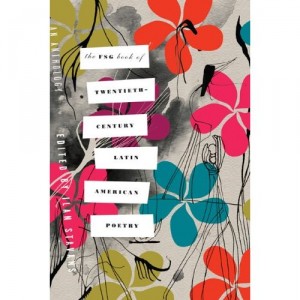Book Review: FSG’s 20th Century Latin American Poetry
 I knew the moment I laid my eyes on The FSG Book of Twentieth-Century Latin American Poetry, that I had to have it. The 728-page bilingual anthology not only brings together the giants of Latin American poetry we are all familiar with — Pablo Neruda, Octavio Paz, and Jorge Luis Borges — it integrates with equal weight the work of lesser-known giants, like Brazil’s Carlos Drummond de Andrade, Perú’s Cesar Vallejo, and Chile’s Vicente Huidobro.
I knew the moment I laid my eyes on The FSG Book of Twentieth-Century Latin American Poetry, that I had to have it. The 728-page bilingual anthology not only brings together the giants of Latin American poetry we are all familiar with — Pablo Neruda, Octavio Paz, and Jorge Luis Borges — it integrates with equal weight the work of lesser-known giants, like Brazil’s Carlos Drummond de Andrade, Perú’s Cesar Vallejo, and Chile’s Vicente Huidobro.
All in all, there are 84 poets from 13 Latin American countries. There is even work from poets writing in Zapotec, Mapuche, Quechua, Nahuatl, Ladino, and even Spanglish — the bastard dialect of Spanish spoken by Latinos in the U.S. and reviled by the Real Academia Española.
The anthology is comprehensive, but not exhaustive, so it begs to be used as a work of reference, and prompts further interaction and investigation; all the poets in the anthology get two to three poems, which seems limiting at first but there are so many poets included that certain concessions surely had to be made. The editor, Ilan Stavans, one of the foremost scholars of Hispanic culture and the Lewis-Sebring Professor of Latin American and Latino Culture at Amherst College, makes an important distinction early on.
Many American scholars believe that Modernism came before Modernismo, but Stavans sets the record straight in the introduction: “Modernism, which, roughly speaking, came about in the English-speaking world a couple of decades later and includes Woolf, Stein, Pound, and Joyce.” Eliot’s Wasteland (1922), for example, comes more than thirty years after Dario’s Azul (1885), an intensely before-its-time collection of poetry.
This book represents a master work on Latin American Poetry constructed by a master verbal architect using highly representative pieces from a tribe of poets that have left their imprimatur on the world of literature. Because Stavans arranges the poets chronologically, reading the anthology from page 1 on creates a trajectory of voice, style, and inflection. So, for example, it becomes increasingly easy to see how the modern bent in José Martí’s “Love in the Big City,” gives rise to Rubén Darío’s “Love Your Rhythm.”
In fact, read enough of Stavans’ anthology and you get a ringside seat of how “the syntax of el español changes throughout the century.” More importantly, the more you read Stavans’ anthology the more you realize Latin American poetry is a different animal than American poetry. According to Stavans, Latin American poets exude “a cosmopolitanism that might verge on disdain for the urgent problems of society, contrasted with an ideological compromise that runs the risk of pamphleteering.”
Yago Cura is a writer based in Los Angeles. He edits the online journal Hinchas de Poesia and moderates the blog Spicaresque. Follow him on Twitter @theshusher.

